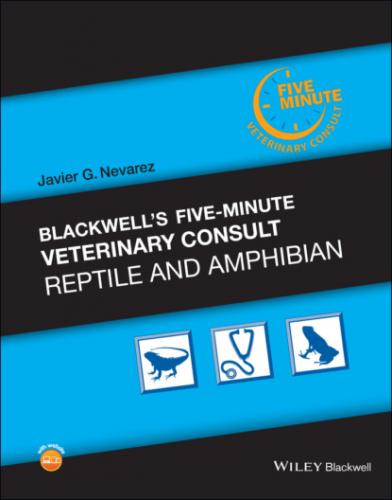APPROPRIATE HEALTH CARE
N/A
NUTRITIONAL SUPPORT
Nutritional supplementation may be indicated if diarrhea, dehydration is severe.
CLIENT EDUCATION/HUSBANDRY RECOMMENDATIONS
Practice proper hygiene
Wash fruits and vegetables before being fed.
Do not house infected individuals with non‐infected chelonians.
DRUG(S) OF CHOICE
Metronidazole 25 mg/kg PO q24h for 5–7 days
PRECAUTIONS/INTERACTIONS
N/A
PATIENT MONITORING
Monitor for weight gain
Take fecal samples
EXPECTED COURSE AND PROGNOSIS
Good
COMMENTS
E. invadens in culture, dies at 37 degrees C, so can raise the temperature to 37 degrees C if it is within the animal’s preferred optimum temperature range.
E. histolytica and E. dispar, which are found in humans GI tracts, are morphologically similar to E. invadens but are considered to be non‐pathogenic.
ZOONOTIC POTENTIAL Unknown
SYNONYMS Amebiasis
ABBREVIATIONS
GI = gastrointestinal
SAF = Sodium acetate acetic acid formalin
INTERNET RESOURCES
de Cardenas C. Amebiasis in Reptiles. PetMD, October 1, 2008. www.petmd.com/reptile/conditions/digestive/c_rp_amebiasis• Amebiasis in Snakes. Wag! 2020. https://wagwalking.com/reptile/condition/amebiasis‐in‐snakes
Divers SJ. Parasitic Diseases of Reptiles. MSD Manual Veterinary Manual, June 2020. www.merckvetmanual.com/exotic‐
and‐laboratory‐animals/reptiles/parasitic‐ diseases‐of‐reptiles
Suggested Reading
1 Denver MC. Reptile protozoa. In: Fowler
2 M, Miller E, eds. Zoo and Wildlife Medicine: Current Therapy 6. St. Louis, MO: Elsevier Saunders ; 2008:154–159. Hnizdo J, Pantchev N., eds. Protozoa (digestive tract). In: Medical Care of Turtles and Tortoises. Diagnosis. Surgery. Pathology.
3 Parasitology. Frankfurt, Germany: Edition Chimaira; 2011:194–195.
4 Jacobson ER. Parasites and parasitic diseases of reptiles. In: Jacobson ER, ed. Infectious Diseases and Pathology of Reptiles: Color Atlas and Text. Boca Raton, FL: CRC Press; 2007:571–665.
Author Elsburgh O. Clarke III, DVM, DACZM
Exophthalmia
DEFINITION/OVERVIEW
Exophthalmia is the anterior protrusion of a normal‐sized globe.
ETIOLOGY/PATHOPHYSIOLOGY
Space‐occupying swelling or mass in the orbit placing pressure on the globe, displacing it anteriorly.
SIGNALMENT/HISTORY
There is no standard signalment for this disease.
Gradual protrusion of the eye, possibly preventing blinking, and potentially anorexia are common findings in the history.
CLINICAL PRESENTATION
While it can be bilateral, exophthalmia is more commonly unilateral.
The displacement of the globe will often push the eyelids forward and cause protrusion of the nictitans, and excessive conjunctiva will be visible.
Retropulsion of the globe is met with resistance due to the presence of retrobulbar swelling.
RISK FACTORS
Husbandry
Inadequate husbandry, especially hypothermia, may predispose animals to this condition due to decreased immune function leading to retrobulbar cellulitis and/or abscessation.
Hypovitaminosis A in chelonians causes squamous metaplasia of the orbital glands and ducts, as well as decreased immune function, and may present as bilateral exophthalmia.
Others
N/A
DIFFERENTIAL DIAGNOSIS
It is important to first differentiate between exophthalmia and buphthalmos.
The most common cause for exophthalmia in chelonians is retrobulbar abscessation.
Other differentials include cellulitis, trauma, granulomas, neoplasia, mucoceles, and sialadenitis.
In tortoises, vascular obstruction and generalized edema have been reported to cause bilateral exophthalmia as well.
DIAGNOSTICS
Physical examination will confirm exophthalmia, but additional diagnostics are necessary to determine the cause.
Ocular ultrasound is helpful in evaluating the problem, although the scleral ossicles can limit visualization.
Advanced imaging, such as CT or MRI, is most helpful in determining the extent of the mass and if
